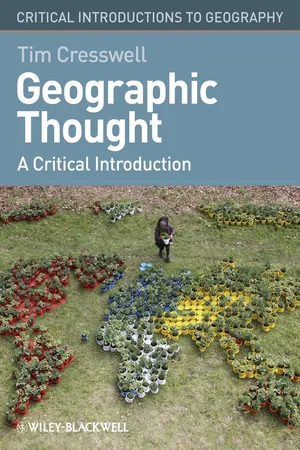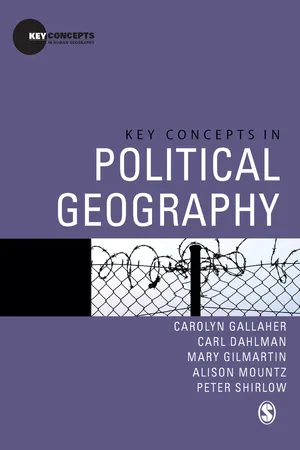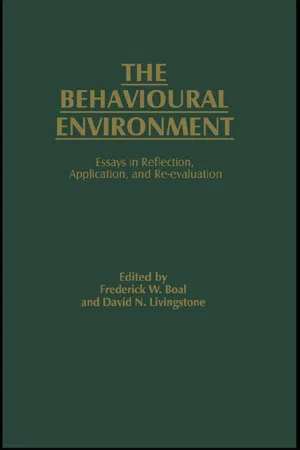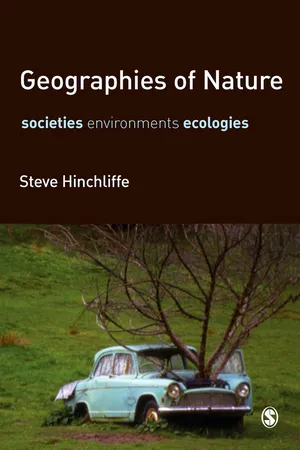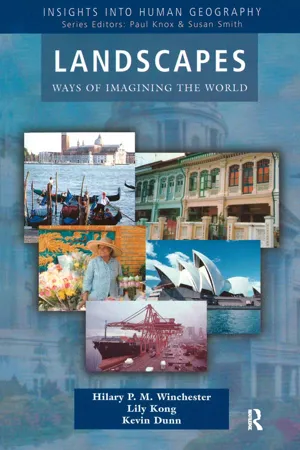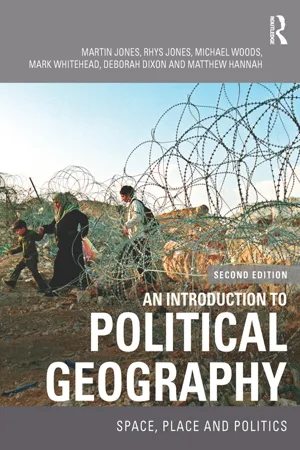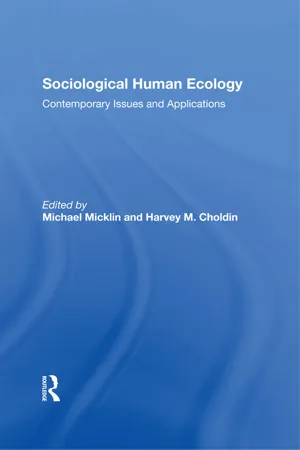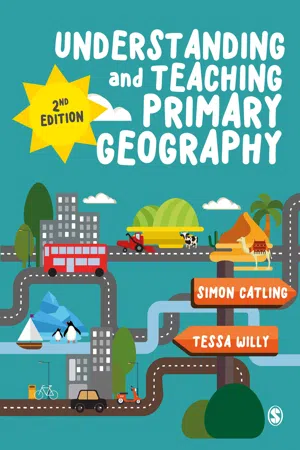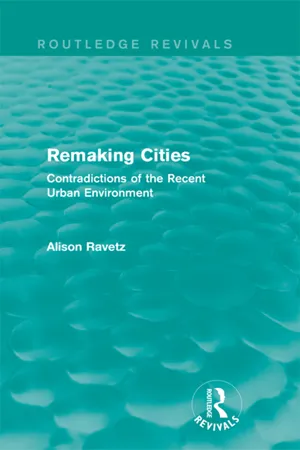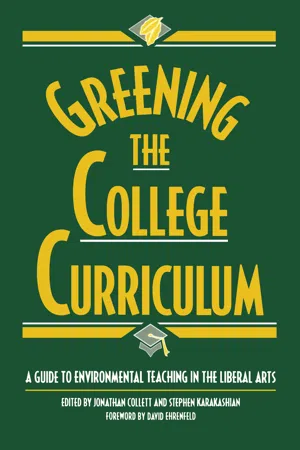Geography
Environmental Determinism
Environmental determinism is a geographical theory that suggests that human behavior and societal development are primarily shaped by the physical environment. This perspective argues that climate, topography, and natural resources dictate cultural and economic practices. While influential in the past, environmental determinism has been widely criticized for oversimplifying the complex interactions between humans and their environment.
Written by Perlego with AI-assistance
Related key terms
12 Key excerpts on "Environmental Determinism"
- eBook - ePub
Geographic Thought
A Critical Introduction
- Tim Cresswell(Author)
- 2012(Publication Date)
- Wiley-Blackwell(Publisher)
Davis references the work of Ratzel and Reclus (see below) approvingly in his defense of geography as the study of causal relations between the inorganic and organic elements of the earth. Although Davis is remembered chiefly as a physical geographer, he lamented the fact that he had not done geography “properly” as he suggested in a letter to his student, Isiah Bowman (who became one of the most preeminent political geographers in the United States): “The chief thing I wish to emphasize is that you should develop geography proper, physiography and ontography properly combined, and not simply physiography as I have done too much” (Beckinsale 1976: 448; Livingstone 1994). Many of Davis’s students were not geomorphologists. Ellsworth Huntingdon was also one of his students. Davis’s evolutionary ideas were easily translated into Environmental Determinism.Environmental Determinism
Perhaps the key problem that lay at the heart of geography in the nineteenth and early twentieth centuries was the relationship between the natural and human worlds. This issue had clearly concerned the proto-geographers of the classical and medieval worlds which had seen the development of elaborate climatic zones in which different peoples were said to display different attributes depending on the climate they had to contend with. The issue of “people–environment” relationships continues to inhabit the heart of the discipline up to the present day. This label is often used to describe a significant strand of learning in North American departments of geography. Scholars describe themselves as “people–environment” geographers. Exactly how people relate to the natural world is currently a contested question, with answers ranging from an environment that determines human life to one in which nature itself is “socially constructed.”But if we go back 100 years there was one strand of thinking that was dominant – Environmental Determinism . When an explanation is deterministic it is one in which one set of things directly causes, in a linear and one-directional way, another set of things. Environmental Determinism is the belief that the natural environment causes and explains the human/cultural world.David Livingstone has argued that a “moral economy of climate” formed a key part of an imperial and racist imagination right up until the middle of the twentieth century. Over and over again, readers of geography journals, as well as thousands of school children and university students reading textbooks, were subjected to the idea that climatic regions were reflected in a moral topography of race. Consider the address to the British Association made by the Scottish geologist, Joseph Thompson, in 1886: - eBook - ePub
- Carolyn Gallaher, Carl T Dahlman, Mary Gilmartin, Alison Mountz, Peter Shirlow(Authors)
- 2009(Publication Date)
- SAGE Publications Ltd(Publisher)
In many ways this change in focus reflects changes in the world around us. When the Cold War ended in 1989 there was uncertainty not only about what would happen to formerly communist states, but also what would happen to the balance of power between states. The emergence of globalization also brought new political actors to the fore, including international organizations, social movements, non-governmental organizations and warlords, among many others. How this mix of old and new actors and the changing relations of power between them will play out is yet to be seen, but political geography will be there to document, analyse and ultimately theorize them.Political Geography through Time
The development of modern political geography was intimately connected with the colonial project (Peet 1985). These connections are readily apparent in the subdiscipline’s two most formative schools of thought – Environmental Determinism and geopolitics. While these approaches initially made the discipline of Geography popular in and out of the academy, they would eventually be debunked, leaving political geography fighting for its survival. A brief introduction to each is provided here. Geopolitics, which has witnessed a resurgence of interest under the label ‘critical geopolitics’, is also discussed in Chapter 7 .Environmental Determinism
Environmental Determinism was developed in the mid-nineteenth century purportedly to explain the discrepancies in standards of living between European colonizers and their colonial subjects. Environmental determinists were influenced by social Darwinism, although most preferred to draw from Lamarckian rather than Darwinian versions of evolution (Livingstone 1992).1 Proponents of the theory, including Friedrich Ratzel, Ellen Churchill Semple and Ellsworth Huntington, posited that climate and topography determined the relative development of a society, and its prospects for future development. Temperate climates were seen as invigorating whereas tropical and arctic climates were deemed to stunt human development. Geographers also postulated that river valleys produced vibrant societies while mountainous environments inhibited them.For much of the early twentieth century, especially in the United States, Environmental Determinism dominated the entire discipline. Even as the approach was becoming a meta-narrative of the field, scholars in other disciplines were subjecting it to withering criticism. The anthropologist Franz Boas labelled the theory simplistic and reductionist because it failed to explain how vastly different cultures could emerge in the same environments (Livingstone 1992). Eventually, geographers would abandon the theory as well. One of the first to do so was Carl Sauer who adopted culture, rather than environment (alone), as the key explanatory variable in human differentiation across space (Livingstone 1992). Half a century later, geographers would describe the discipline’s fixation with geographic determinism as an imperialist impulse (Peet 1985; Smith 1987). - eBook - ePub
The Behavioural Environment
Essays in Reflection, Application and Re-evaluation
- F.W. Boal, D.N. Livingstone(Authors)
- 2003(Publication Date)
- Routledge(Publisher)
The idea that the environment must be understood in terms of the way people perceived it was a major step forward in human geography. It recognized that it was people’s understanding of environment, not environment itself, that shaped their actions, but it did not elaborate on a means of determining the meaning of the environment itself in the broader context of a society’s priorities and visions of order. A human geography dedicated to investigating human activities or forms of life in their historical contexts seeks to establish a broader basis for understanding the character of human activities on the surface of the earth and their connections to the physical environment.Acknowledgement
I am grateful to my colleagues Jean Andrey, Roy Officer, and Peter Nash for their critical comments on an earlier draft of this chapter. The responsibility for the ideas expressed herein remains entirely mine.Notes
1 This integration of physical and human geography is typified in the work of such environmental determinists as Ellsworth Huntington, Griffith Taylor, and Ellen Churchill Semple.2 G.Tatham, ‘Environmentalism and possibilism’, in G.Taylor (ed.), Geography in the Twentieth Century, 3rd edn (Methuen, London, 1953), pp. 128–62.3 C.O.Sauer, ‘The morphology of landscape’, University of California Publications in Geography no. 2 (1925), University of California, Berkeley, pp. 19–54; J.K.Wright, ‘Terrae incognitae: the place of the imagination in geography’, Annals of the Association of American Geographers, vol. 37 (1947), pp. 1–15; W.Kirk, ‘Historical geography and the concept of the behavioural environment’, Indian Geographical Journal, Silver Jubilee Volume (1952), pp. 152–60.4 Kirk, ‘Historical geography and the concept of the behavioural environment’, p. 159.5 For example, T.F.Saarinen, ‘Perception of the drought hazard on the Great Plains’, Research Paper no. 106 (1966), Department of Geography, University of Chicago; and P.Gould and R.White, Mental Maps - eBook - ePub
Geographies of Nature
Societies, Environments, Ecologies
- Steve Hinchliffe(Author)
- 2007(Publication Date)
- SAGE Publications Ltd(Publisher)
Determinism is a form of philosophical reasoning which holds that every event, including matters as diverse as cognition and hurricanes, can be explained by a causal chain of other events and processes. There is no randomness, no magical input, no mysterious term that can be used to account for an event. In geographical thought the most common expression of such reasoning has been Environmental Determinism, the suggestion that human activities are controlled by the physical environment (Glacken, 1967) itself playing into and fuelling a form of naturalized North European supremacism (Livingstone, 1992). In studies of science and technology, a good deal of work has been done to unseat technological determinism – the belief that, for example, social, economic and political forms could be explained by the fixed properties of technologies. In both cases, the form of argument is similar in that variations in material form and function are used to explain variations in social and cultural activity. And, the former variations can be explained with reference to first principles, or, in other words, to nature. Another type of determinism is historical determinism which holds that irrespective of actions taken, events will unfold along a pre-set trajectory. The latter is sometimes linked to structural materialism and is associated with Marxism. However, it is important to note that not all forms of Marxism are determinist. Indeed, rather than demonstrating the highly structured linear narratives of historical determinism, Marxism is at its most productive when open and multiform flows render new possibilities for political action practicable. On the possibilities for these more open or aleatory Marxisms, see Bennett (2004).A second and related problem is that, in being deterministically produced, these ‘interactive’ forms are rendered as passive entities. Children, landforms, prions, whatever, can end up looking like nothing but manifestations of two active realms which interact in more or less complex ways. All the action is passed backwards to the formative processes that are either nature or culture. These entities are then products of history and geography and have no hand in the making of those histories or geographies. All of this is tantamount to suggesting that things really don’t have history or spatiality at all. For if things are but manifestations of already settled matters (nature and culture), then their form is already describable prior to the event of their gestation. Which is the same as saying that really nothing has happened. Things are simply doing what they are told, or what has already been determined for them. Things are just surface manifestations of already settled matters. At another resolution, nothing has changed. - eBook - ePub
Environmentalism and Cultural Theory
Exploring the Role of Anthropology in Environmental Discourse
- Kay Milton(Author)
- 2002(Publication Date)
- Routledge(Publisher)
Probably none of the analysts who sought environmental explanations for cultural phenomena would have denied that culture also influences environmental change. To have done so would have appeared absurd, given that the ethnographic literature abounds with descriptions of the ways human societies modify their environments to meet their needs: the burning of bushland by hunting communities to encourage the new growth which attracts and sustains game; the manipulation of water flows through irrigation schemes; the clearing of forests for cultivation; and so on. But Environmental Determinism, by definition, addresses only the influence of the environment on culture, and ignores the complementary process. Once it is assumed, for analytical purposes, that environments shape cultures, then the possibility of asking how cultures shape environments is effectively precluded.There is a further reason why Environmental Determinism is incompatible with the environmentalist concern to protect the environment through human effort. The assumption that human activities are somehow caused by environmental factors, that the environment is the ‘prime mover’ in human affairs, implies that human beings are helpless in the face of natural forces, in much the same way that some religious doctrines imply that we are helpless in the face of supernatural forces. In other words it induces a ‘rationality of fatalism’, in which planning is redundant and in which ‘outcomes, good or bad, are simply to be enjoyed or endured, but never achieved’ (James et al . 1987: 9). While a fatalist perspective might accord closely with many people’s experience of the world, it has limited potential as a basis for action.The approaches described above were prominent at a time when the prevailing concept of culture employed by anthropologists embraced actions and the material products of action as well as what people hold in their minds – thoughts, feelings, ideas, knowledge. Many of the anthropologists engaged in ecological studies focused primarily, or even exclusively, on these more readily observable components of culture. Hawley, for instance, discussed culture in terms of the ‘techniques’ and ‘habits’ involved in ensuring survival (Hawley 1944: 404; 1950: 68), while Steward defined culture as ‘learned modes of behaviour that are socially transmitted’ (1955: 44). When, from the late 1950s, anthropologists increasingly restricted the term ‘culture’ to what cannot be directly observed, the components in which ecological anthropologists had shown the most interest were more or less excluded from the concept. This marked a parting of the ways in ecological anthropology. Those analysts who retained a prime interest in the workings of ecological relations found that they could get by quite well without the modified concept of culture. Those who wished to explore the analytical potential of the new, narrower concept of culture, shifted their emphasis from ecology to ‘ethnoecology’ (Fowler 1977), and redefined the relationship between culture and environment as one of cultural determinism. - eBook - ePub
Landscapes
Ways of Imagining the World
- Hilary P.M. Winchester(Author)
- 2013(Publication Date)
- Routledge(Publisher)
In the primary state of development [of the geography of religion], the focus was on a one-sided presentation of religion as determined by its environment; environmental explanations were sought, appropriately or otherwise, to aid the understanding of the origin of religions and religious practices. In the second stage of antithesis, the geography of religion moved to a one-sided study of the moulding influence of religion on its environment, to the point of shaping the settlement and landscape…. the field has clearly entered a third stage of development — synthesis…. a synthetic approach that focuses on the reciprocal network of relations between religion and environment.In the following three sections, works within cultural geography and cognate disciplines are used to demonstrate the abovementioned shifts in the study of cultural landscapes. In sequence, these are, first, Environmental Determinism, then through the Berkeley School of cultural determinism, finally to the new cultural geographies.2.1 Environmental Determinism
In the earlier part of the twentieth century, geographers explored how different environments generated differing cultures. In these works, geographers would demonstrate how the environment (including landscapes) was an independent variable or agent that determined culture. As the environment varied, so would cultures. Perhaps the most well-known treatise on Environmental Determinism was Ellen Semple's Influences of Geographic Environment. Semple (1911 :1) made the argument plain: ‘Man [sic] is a product of the earth's surface.’ Similarly, one of the founders of Australian geography, Griffith Taylor (1940 :424–48), asserted that geography was able to demonstrate how humans were conditioned by their environment. Indeed, Griffith Taylor carried Environmental Determinism into the 1950s in Australia, long after the Berkeley School approach had diffused throughout North American geography.Climate was shown by geographers to have influenced the myths and rituals of religions. Ellen Semple (1911 :41) observed that in Eskimo culture, Hell was a place of extreme cold, whereas both Muslim and Christian sacred texts depict Hell as comprising fire and boiling water and Heaven as a garden. In the Qur'an, Heaven is described as a ‘Garden underneath which rivers flow’ (see V:85; XIII:35; XLVII:15). The climate of Hell for Christians is mostly an inferno, although the maps of Hell made by Dante, an Italian poet and commentator of the fourteenth century, also included sites of extreme cold (see Astarotte, 2001 - eBook - ePub
An Introduction to Political Geography
Space, Place and Politics
- Martin Jones, Rhys Jones, Michael Woods, Mark Whitehead, Deborah Dixon, Matthew Hannah(Authors)
- 2014(Publication Date)
- Routledge(Publisher)
Environmental Determinism exists when key features of a society, culture or political community are attributed to prevailing environmental conditions (including resource availability, climate, soil quality inter alia) (see Sluyter 2003). Critiques of Environmental Determinism argue that such accounts of the world tend to naturalise the often unjust socio-economic and political conditions people around the world find themselves in, and disconnect these conditions from the broader political and economic systems that contribute towards their production (ibid.). In response to the problems associated with Environmental Determinism, Political Ecology has offered an alternative, and more critical, account of the relations between the physical environment and politics. Political Ecology finds it antecedents in the 1980s with the pioneering work of Piers Blaikie. In his 1985 book Political Economy of Soil Erosion in Developing Countries, Blaikie challenged Malthusian notions that soil erosion was caused by over-population, and environmental determinist perspectives that argued it was the consequences of climatic fluctuations. Blaikie argued that soil erosion was actually the consequence of prevailing political and economic structures, which often saw peasant farmers having their land seized, being poorly paid and becoming economically marginalised (see Blaikie 1985; Blaikie and Brookfield 1987). It was these conditions, according to Blaikie, which forced farmers to work commercially unviable land, and which ultimately led to soil erosion and the breakdown of the peasant agricultural economy. Blaikie’s early work has provided the basis for a rapidly expanding portfolio of work on Political Ecology - Roger Minshull(Author)
- 2014(Publication Date)
- Routledge(Publisher)
Geographers think they are able to show that the same cause is not followed by the same effect when they show two ‘identical’ natural regions with different types of land use. Martin insists that it is just the over-simplification of such geographers that makes two environments seem to be identical. The regularities which we do observe in the real world, however, could not happen if there were no determinism at all, so the conclusion Martin reaches, completely convincingly, is that determinism must exist, but the chain of cause and effect is very complicated indeed. No two places, no two times, no two groups of people are exactly alike. In any place, at any time the environment has been one of the factors in determining what man will do. In Martin’s view geography is the discipline which studies this set of factors. But because of the infinite variation of the factors and elements involved, the result of this deterministic cause and effect is unique in every case. ‘Geographers do not assert that the geographic environment is the only or even the most important determinant of human activity, they merely state that their particular business is to examine this group of determinants rather than others.’ 27 In agreeing wholeheartedly with Martin, the author would emphasise two points. First, the phrase too easily overlooked, that the influences which geographers study may be much less important in deciding human actions than other influences outside geography’s terms of reference. Second, the important lesson of this paper seems not that determinism is inevitable, but that its processes are so complex- eBook - ePub
Sociological Human Ecology
Contemporary Issues And Applications
- Michael Micklin, Harvey M Choldin(Authors)
- 2019(Publication Date)
- Routledge(Publisher)
Geography is concerned primarily with the uses of space and the environment (Hagerstrand, 1973). Its substantive domain is, generally, the location and distribution of “things”—resources, activities, people, etc. But, like other disciplines, geography can be divided into a number of specialities, e.g., physical geography, resource geography, social geography, cultural geography and human geography. Recent discussions of some of these specialty areas, principally human, social, and cultural geography, reflect a concern with systems of relationships between man and the physical environment (e.g., Pahl, 1965; Hobson, 1969; Berry, 1973; Hagerstrand, 1973). Thus, within this discipline there is an emerging recognition of a close connection to human ecology.Older conceptions of human geography viewed the unit of analysis as the “natural geographic region” (McKenzie, 1934), while more recent approaches reflect an emphasis on areas defined in terms of systems of human activities (e.g., Pahl, 1965; Hobson, 1969; Berry, 1973). It has even been suggested that “Nowadays virtually every suggestion having to do with the restructuring of geography and with its need to increase its relevance with respect to current environmental problems involves, explicitly or implicitly, the application of some measure of systems analysis” (Chorley, 1973:165).Early geographic approaches to human activities were variations on the “Environmental Determinism” theme (Clarkson, 1970). Increasingly, though, it is recognized that this relationship should be reversed. It is the human presence, defined in terms of population size and distribution, patterns of movement, activities and the decisions that guide them, cultural orientations to the environment, and so on that influence environmental variables, Brian Berry (1973:14), one of the most ecologically-oriented of present-day geographers, explicitly proposes use of the ecosystem concept. He presents a “behavioral model of spatial process” which views the ecosystem as a product of interacting natural and cultural processes (also see Stoddart, 1965).Consistent with the current emphasis on man’s intrusion into and control of the natural environment, geographers are increasingly likely to explain patterns of resource use and availability in terms of social organization and “beliefs and perceptions” (Berry, 1973:14; also see Berry and Kasarda, 1977:417–429). Accordingly, changes in ecological systems are now seen as the result of changes in social and cultural institutions related to the environment (Stoddart, 1965; Berry, 1973). Adaptation, as a mechanism of change, is not yet a key concept in the vocabulary of the geographers. - eBook - ePub
- Simon Catling, Tessa Willy(Authors)
- 2018(Publication Date)
- SAGE Publications Ltd(Publisher)
environmental geography. These aspects of geography have a long history – for instance, when regional geography was a dominant approach in school geography in the first half of the twentieth century, regions were discussed in terms of their physical geography, including rivers, lakes, plains, mountains, valleys, ecology and geology, and their human geography, such as types of industry, products, trade, settlements, commerce and ways of life. However, they were rarely considered in terms of environmental geography – for instance, how people have changed the landscape over time, human impact on climate, extracting resources, deforestation and pollution. Understanding physical, human and environmental geography is important to understand our planet, our lives and their incontrovertible interrelationships. This is the focus of this chapter, but we begin by noting briefly the geological context in which we live.Living in a geological epoch
The interrelationship between the physical environment and human activities is argued to have become much greater in recent centuries. It is contended that humans have had such an impact on the natural environment that we should have a new name for the current geological time in which we live and that this name should be the Anthropocene (Hamilton et al., 2015; Goudie and Viles, 2016; Bonneuil and Fressoz, 2017). The term ‘Anthropocene’ is being used to identify a ‘new’ geological epoch (Schwägerl, 2014; McNeill and Engelke, 2014). Its purpose is to reinforce just how significant humans have become in affecting the physical environment of the Earth. We have done this, it is argued, through our actions, such as deforestation, energy extraction and generation, mobility and travel, urbanisation and industrial practices (Goudie, 2013; Holden, 2012; Whitehead, 2014; Goudie and Viles, 2016; Kress and Stine, 2017). Such developments have led to changes in our vegetation, land cover, oceans, atmosphere and climate, and weather systems and patterns. One impact is described in the term ‘climate change’ and debated in relation to the warming of the Earth’s atmospheric and ocean temperatures (Maslin, 2014). This is having the effect of heating our planet at a much faster rate than has hitherto happened, hence the use of the phrase ‘global warming’ (Maslin, 2014). The Earth’s climate has constantly changed; the difference today is that it is happening, in geological terms, very quickly, and that it appears already to be affecting our environments and lives very seriously through such events as higher temperatures and increased and heavier rainfall, resulting in such effects as the increased frequency and severity of storms, flooding, drought and wildfires (Core Writing Team et al - eBook - ePub
Remaking Cities (Routledge Revivals)
Contradictions of the Recent Urban Environment
- Alison Ravetz(Author)
- 2013(Publication Date)
- Routledge(Publisher)
9 EXPERIENCING THE ENVIRONMENT: PEOPLE, PLACE AND SPACEDOI: 10.4324/9780203732212-111 The Practice of Environmental Determinism
The element that has so far been lacking from our analysis of agents in the built environment is people. We have of course considered them incidentally as the creators of ‘value’ through their labour, as the motivators of planning policies, and participants in and users of the environment, as various environmental professionals defined it. But we have not so far considered what, if anything, they themselves contribute directly, or what constraints they operate under in the environment. The last chapter, as earlier ones dealing with the land market and problems of architecture, drew attention to the cultural specificity of design images and decisions. Both the British and the Third World experience suggests that who controls built environments, and in particular whether their users have any degree of autonomy, is a critical point. From this arises the principle that environments may have such different meanings for different groups – and particularly for the users and the official planners – that the degree to which they may be objectively measured and evaluated is often limited. While it may be quite proper for the environmental professions to pursue their own criteria, when we are considering not just limited professional goals but the built environment in its totality, the most proper criterion is social: that is, to do with its function and meaning in society. For in spite of professionals’ claim to have a monopoly over it, the environment is not the product of environmental specialisms but is rather the product of innumerable people and their activities operating over a long period of time.This chapter is therefore concerned with the experience and contribution of people in environments. Most of the evidence quoted is drawn from British experience. It may have many parallels in other cultures, but the precise limits of these are not always known and no attempt is made to define them here. As elsewhere in this book, it is British evidence that is used as the raw material for the analysis of a problem or set of problems; but it is likely that the principles involved, if not the details, are fairly ubiquitous. - eBook - ePub
Greening the College Curriculum
A Guide To Environmental Teaching In The Liberal Arts
- Jonathan Collett, Stephen Karakashian, Jonathan Collett, Stephen Karakashian(Authors)
- 2013(Publication Date)
- Island Press(Publisher)
The approach of geographers to the study of environmental change emphasizes spatial pattern, a large scale of inquiry (over space and time), and the integration of social and natural sciences. Geographers typically conduct research at the level of landscape or region; for example, considering land use patterns and their impact on vegetation in a drainage basin or watershed. Recently, geographers have begun working at much broader scales. Such a study is under way in Mexico, where Liverman (1990) is investigating the capacity of small-scale farmers to cope with climatic change over several decades. Research elsewhere documents local adaptation in land management upon elevated exposure to storms, oil spills, flooding, and other forms of environmental risk (Kates and Burton 1986).While geography as a discipline encompasses a broad realm of inquiry, geographers as individuals tend to specialize in either human or physical studies, often borrowing methods of analysis from other disciplines. Geographers traditionally break the study of human transformation of the biosphere into four fields: (1) regional studies, (2) people—environ-ment studies, (3) environmental processes and resources, and (4) spatial analysis.Regional Studies
Geographers working in this tradition address conservation issues relevant to a particular place. A regional focus allows students to understand how the physical characteristics and social history of a place have led to a unique land use system. Students may draw on this insight to evaluate the sustainability of a land use system and to predict how changing external and internal factors may result in the transformation or degradation of a landscape (Leighly 1969). For example, many Latin Americanist geographers examine how deforestation in the Amazon is driven by distinctive regional characteristics such as land tenure patterns, demographic features, government policies, and agricultural and economic systems (Hecht and Cockburn 1989; Smith 1982).People—Environment Studies
Within this broad focus, geographers explore the relationship between society and nature in terms of causes and consequences. The justification for environmental conservation is likely to vary dramatically according to a society’s own view of its relationship with nature. Ancient writers such as Hippocrates, Ptolemy, and Strabo expressed a profound desire to define the human role in the natural world. Since then, many philosophies have developed, ranging from the Christian doctrine of defining man as master of nature (Glacken 1956) (see Chapter 11, Religion), to Romantic/Arcadian ideas of humanity in harmony with nature (O’Riordan 1981) (see Chapter 7, Literature), to deterministic theories akin to social Darwinism that individual and social characteristics are formed by the physical environment (Semple 1911), to notions that human choice is influenced primarily by cultural and historical factors (Lewthwaite 1966). (These latter viewpoints are discussed fully in Chapter 2, Anthropology.) Accordingly, the aim of conservation will vary in terms of what type of human intervention in ecosystems a given society considers desirable.
Index pages curate the most relevant extracts from our library of academic textbooks. They’ve been created using an in-house natural language model (NLM), each adding context and meaning to key research topics.
